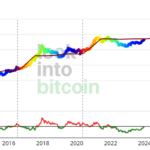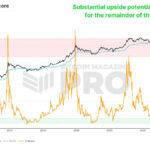As we step into 2025, the Bitcoin market is abuzz with anticipation as investors delve into historical data and seasonal trends to gain insights into what February might have in store. With Bitcoin's cyclical nature closely linked to its halving events, a look back at past performance can serve as a valuable guide for predicting future trends. By analyzing historical data, including Bitcoin's average monthly returns and its performance in February following halving events, we aim to paint a clear picture of what February 2025 could entail.
Deciphering Bitcoin's Seasonal Patterns
The "Bitcoin Seasonality" chart provides a glimpse into the average monthly returns from 2010 up to the latest monthly close. This data sheds light on Bitcoin's top-performing months and its cyclicality. February has historically boasted an average return of 13.62%, positioning it as one of Bitcoin's stronger months in terms of performance.
Noteworthy outliers include November, with the highest average return of 43.74%, closely followed by October at 19.46%. On the flip side, September has typically been the weakest month, posting an average return of -1.83%. Given February's robust performance, it ranks high in Bitcoin's seasonal trends, offering investors optimism for positive returns at the beginning of 2025.
Historical Performance of February After Halving Events
A deeper analysis of Bitcoin's historical February returns unveils intriguing insights for years following a halving event. Bitcoin's halving process, occurring approximately every four years, halves block rewards and triggers a supply shock that historically propels price surges. February's performance in these post-halving years has consistently been positive:
- 2013 (Post-2012 Halving): 62.71%
- 2017 (Post-2016 Halving): 22.71%
- 2021 (Post-2020 Halving): 36.80%
The average return across these three years stands impressively at 40.74%. Each of these Februarys reflects the bullish momentum often witnessed after halving events, driven by reduced Bitcoin supply issuance and heightened market demand.
Setting the Stage: January 2025 Performance
Although February 2025 lies ahead, the year commenced with a modest 7.28% return in January, as illustrated in the "Monthly Returns Heatmap." January's positive performance suggests a continuation of bullish sentiment in the early months of 2025, aligning with historical post-halving trends. If February 2025 mirrors past post-halving year trajectories, potential returns could fall within the 22% to 63% range, with an average expectation around 40%.

Factors Driving February's Post-Halving Strength
Several factors contribute to February's historical robust performance in post-halving years:
- Supply Shock: The halving slashes new Bitcoin supply, enhancing scarcity and fueling price appreciation.
- Market Momentum: Investors typically respond to halving events with increased enthusiasm, driving prices upwards in the ensuing months.
- Institutional Interest: Recent cycles have witnessed accelerated institutional adoption post-halving, injecting significant capital inflows into the market.
Key Insights for February 2025
Approaching February 2025 with cautious optimism seems prudent. Insights from historical and seasonal data suggest the month holds promise for positive returns, especially within the context of Bitcoin's post-halving cycles. With an average return of 40.74% in previous post-halving Februarys, investors could anticipate a similar performance this year, barring substantial macroeconomic or regulatory challenges.
Looking Ahead
Bitcoin's history acts as a valuable guide for anticipating its future trajectory. February 2025 appears poised for another fruitful month, driven by the familiar dynamics following halving events that have historically led to significant gains. By combining historical performance data with a positive regulatory landscape, increasing institutional acceptance, and pivotal accounting changes affecting Bitcoin, 2025 emerges as a transformative year for the cryptocurrency. Investors should complement these insights with comprehensive market analysis and brace themselves for Bitcoin's inherent price volatility.
This article provides insights for informational purposes and should not be construed as financial advice. Conduct thorough research before making any investment decisions.
Frequently Asked Questions
Who has the gold in a IRA gold?
The IRS considers anyone who owns gold to be “a form money” and therefore subject to taxation.
You must have gold at least $10,000 and it must be stored for at the least five years in order to take advantage of this tax-free status.
Owning gold can also help protect against inflation and price volatility, but it doesn't make sense to hold gold if you're not going to use it.
If you are planning to sell your gold someday, it is necessary that you report its value. This can affect the capital gains taxes that you owe when cashing in on investments.
Consult a financial advisor or accountant to determine your options.
Do You Need to Open a Precious Metal IRA
The most important thing you should know before opening an IRA account is that precious metals are not covered by insurance. You cannot recover any money you have invested. This includes all investments that are lost to theft, fire, flood, or other causes.
Protect yourself against this type of loss by investing in physical gold or silver coins. These coins have been around for thousands and represent a real asset that can never be lost. You would probably get more if you sold them today than you paid when they were first created.
When opening an IRA account, make sure you choose a reputable company offering competitive rates and high-quality products. Consider using a third-party custody company to keep your assets safe and allow you to access them at any time.
When you open an account, keep in mind that you won't receive any returns until your retirement. So, don't forget about the future!
What Should Your IRA Include in Precious Metals?
It is important to remember that precious metals can be a good investment for anyone. It doesn't matter how rich you are to invest in precious metals. You can actually make money without spending a lot on gold or silver investments.
You might think about buying physical coins such a bullion bar or round. Stocks in companies that produce precious materials could be purchased. Another option is to make use of the IRA rollover programs offered by your retirement plan provider.
No matter what your preference, precious metals will still be of benefit to you. Although they aren’t stocks, they offer the possibility for long-term gains.
Their prices rise with time, which is a different to traditional investments. If you decide to sell your investment, you will likely make more than with traditional investments.
Statistics
- Gold is considered a collectible, and profits from a sale are taxed at a maximum rate of 28 percent. (aarp.org)
- Indeed, several financial advisers interviewed for this article suggest you invest 5 to 15 percent of your portfolio in gold, just in case. (aarp.org)
- Instead, the economy improved, stocks rebounded, and gold plunged, losing 28 percent of its value in 2013. (aarp.org)
- If you take distributions before hitting 59.5, you'll owe a 10% penalty on the amount withdrawn. (lendedu.com)
- Contribution limits$6,000 (49 and under) $7,000 (50 and up)$6,000 (49 and under) $7,000 (50 and up)$58,000 or 25% of your annual compensation (whichever is smaller) (lendedu.com)
External Links
cftc.gov
irs.gov
wsj.com
- Saddam Hussein's InvasionHelped Uncage a Bear In 1991 – WSJ
- Are you interested in keeping gold in your IRA at-home? It's not exactly legal – WSJ
law.cornell.edu
- 7 U.S. Code SS 7 – Designation of boards of trade as contract markets
- 26 U.S. Code SS 408 – Individual retirement plans
How To
Guidelines for Gold Roth IRA
The best way to invest for retirement is by starting early. You should start as soon as you are eligible (usually at age 50) and continue saving throughout your career. It is essential to save enough money each year in order to maintain a steady growth rate.
You can also take advantage of tax-free savings opportunities like a traditional 401k (k), SEP IRA (or SIMPLE IRA). These savings vehicles permit you to make contributions, but not pay any tax until your earnings are withdrawn. This makes them great options for people who don't have access to employer matching funds.
The key is to save regularly and consistently over time. You'll miss out on any potential tax benefits if you're not contributing the maximum amount allowed.
—————————————————————————————————————————————————————————————–
By: Mark Mason
Title: Forecasting Bitcoin Price Trends for February 2025
Sourced From: bitcoinmagazine.com/markets/what-bitcoin-price-history-predicts-for-february-2025
Published Date: Thu, 16 Jan 2025 18:24:39 GMT















